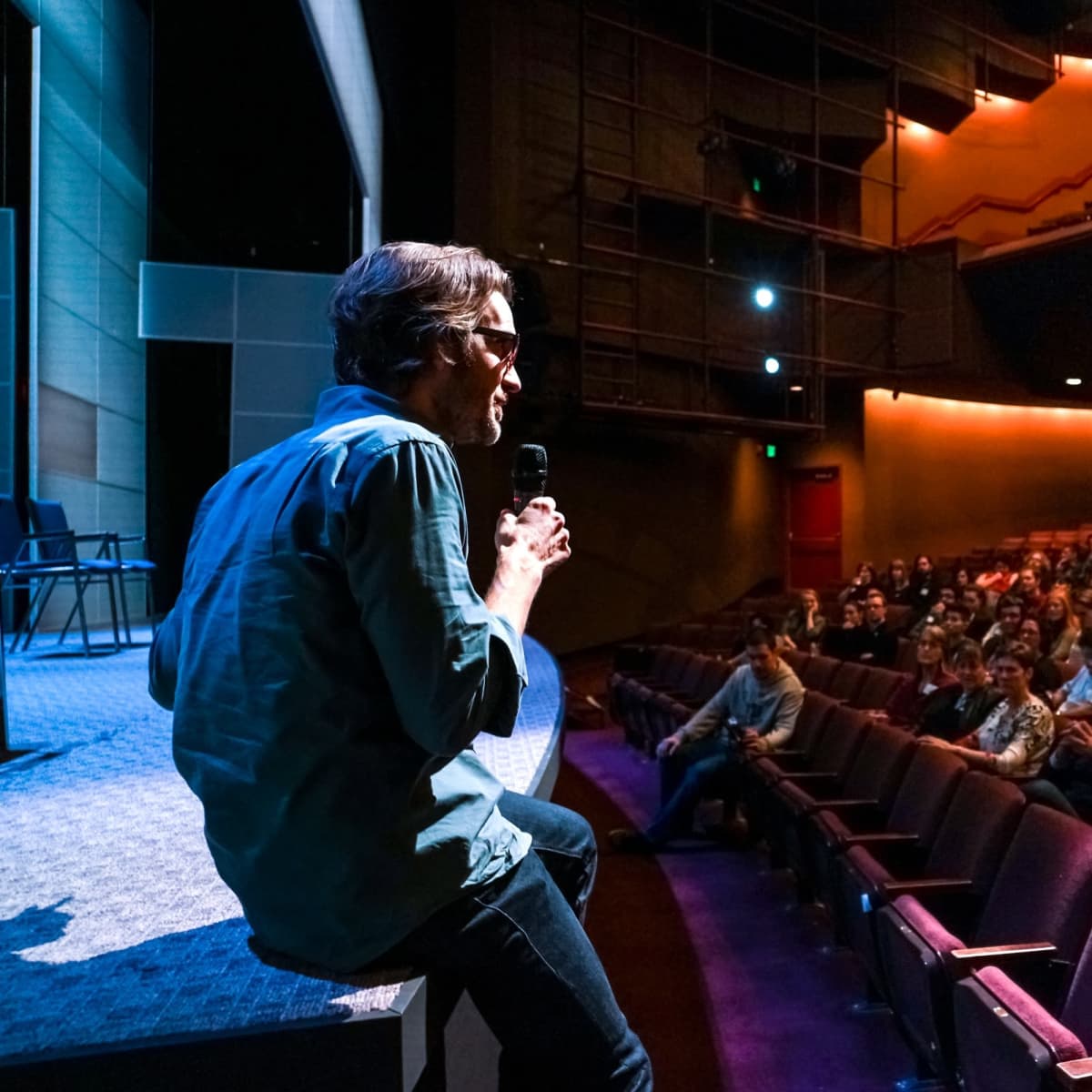Article
Indecent: A Travelogue
Director Sheila Daniels journeys to Poland in researching Indecent
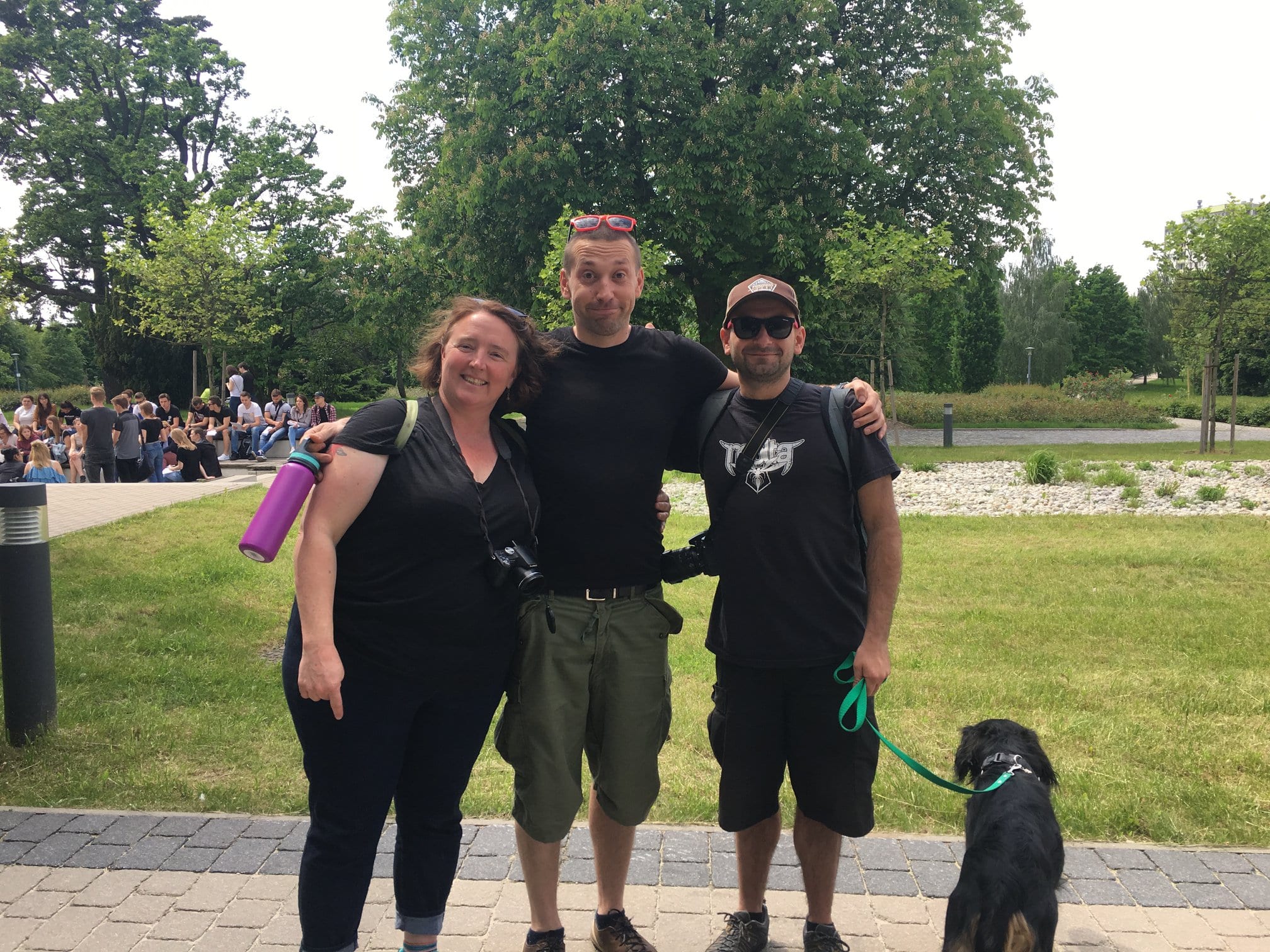
Sheila, Marcin, Lukasz, and Misha at Survivors Park in Łódź
It began with Łódź. In between reading the play and doing research on it, the other locales were familiar. Places I could grasp. Yet Łódź was elusive. I found myself craving to know it, and then to walk other places these characters had trod in Poland, a country I’d always been fascinated by, but never even thought of actually going to. To feel the ground beneath my feet. The ground of Auschwitz-Birkenau, where so many were murdered, but also the ground in Kraków and Warsaw and Łódź where they lived and loved and gave so much to our world in the arts and social justice and philosophy and so many other areas.
My cousin, Morgen, agreed to go with me and we began making our plans: Kraków, Warsaw, Łódź (including Radegast station), Auschwitz-Birkenau, Kraków.
What we could never have planned was the generosity of the people we met along the way – whether it was Wojtek, Marcin, Łukasz, Inés, Paul and Ilona - who each gave us hours of their time – or the woman at the bus stop who showed us a remaining portion of the ghetto wall in Warsaw or other people we met in passing.
We stayed our first day in Kraków, largely to begin to get acclimated and get some jet-lag recovery. More later on Kraków at the end of our trip, but it’s important to note it here as a contrast to the other places we would go as it is a jewel of a city, with much of the pre-war architecture preserved and revitalized.
Warsaw
On our first night in Warsaw we met Paul Bargetto, an ex-pat friend of a friend, and his fellow artist, Ilona Binarsch. Arrangements were made to meet at the Bar Studio in Pałac Kultury (Palace of Culture), where the state Theatre companies reside: a huge, Soviet Era building “gifted” to the Polish people by Stalin. Our lively conversation was based largely on contemporary theatre practices and politics – Paul would be one of many people to compare the political climate of Poland to that of the United States.
As we left, they showed us the gold strip embedded in the sidewalk memorializing the Warsaw Ghetto - it stretches throughout the city, encompassing the boundaries of the ghetto. We would run into it regularly in our travels through the city.
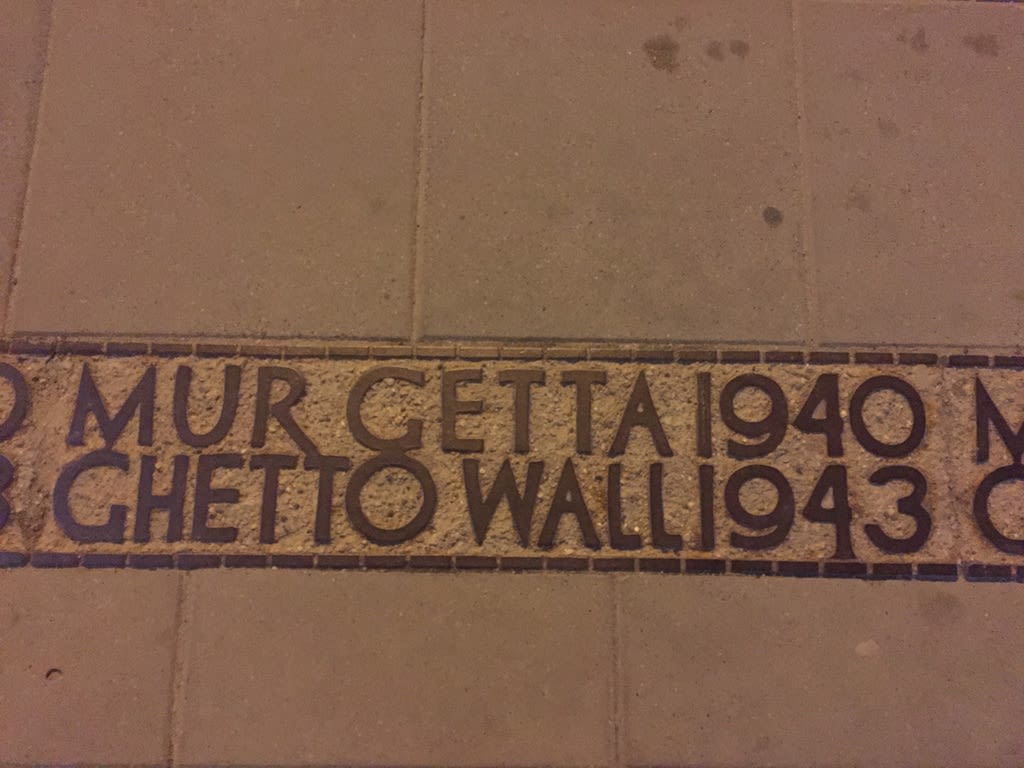
The next day we were scheduled to meet with Wojtek Zrałek-Kossakowski the next day for lunch: what we expected was a 1 – 2 hour lunch, but received an email that night from him the next day that made it clear that he was planning on being with us all day.
Through his generosity of time and contacts, Wojtek was our gateway to people and places we might never have met or seen without his help.
Time with Wojtek
We met at the same Bar Studio we’d been at the night before: Wojtek was described by the person who connected us with him as “knowing everything and everybody there is to know in the theatre in Warsaw.” He is a true Varsovian – born and raised in the city and deeply knowledgeable about the city and its past and present. Over what was to be one of many delicious meals we ate in Poland, we discussed theatre, politics, family and much more. Following our meal, he took us on a tour of the smaller of the state theaters and its many spaces, including watching a show in rehearsal – with an enormous puppet and on a turntable - from the catwalk of the main space. Hi favorite space is a black box with flexible seating – a soulmate!!!

The outside of the State's Childrens' Theatre
Wojtek then took us on a long walk to his apartment, taking us on a route to show us a small group of buildings that were some of the very few remaining from before WWII – the Nazis razed 90% of the city to the ground, including the entirety of the Jewish Ghetto following the famous uprising. Thus, Warsaw is now dominated by Soviet era architecture and contemporary architecture.
Our tour ended at his home, where we picked up his partner Inés’ daughter and were off to meet her at a gallery, stopping along the way to pick up tickets to see two work via the company Komuna Warsawa the following evening. Our time with them was delightful – viewing a few galleries including a rooftop exhibit, then having chocolate drinks at one of the many cafes we’d seen along our tour. Political discussions arose again, particularly around racism in both of our countries, and the shared hope that we can create change. After leaving these new friends, and with great hopes we would all stay in touch, we headed back to our Warsaw home, stopping for some divine pierogis and pivo (beer).
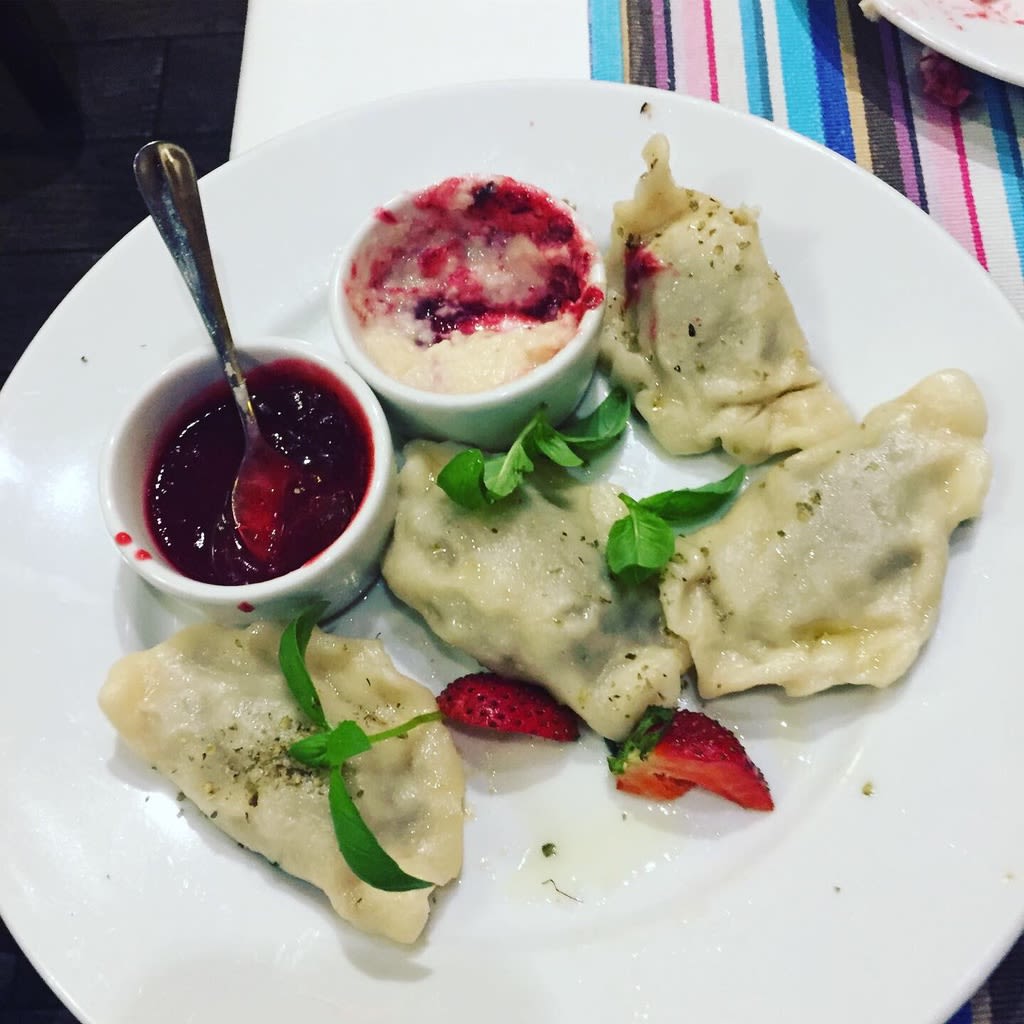
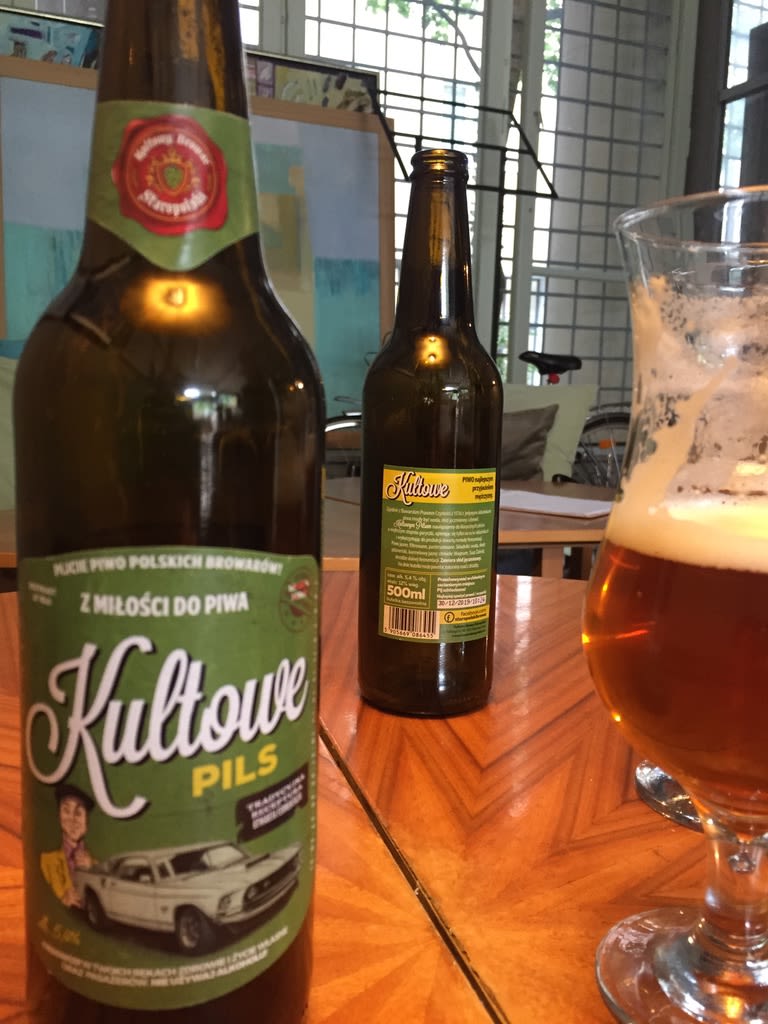
Divine pierogis and pivo (beer)
The POLIN Museum, Moscow
Our third day, in Moscow, was devoted in large part to POLIN – a relatively new museum of the history of the Jewish people in Poland from the Middle Ages up to current times. It quickly became clear that, like any broad-ranging museum, I had to pick and choose what I paid closest attention to.
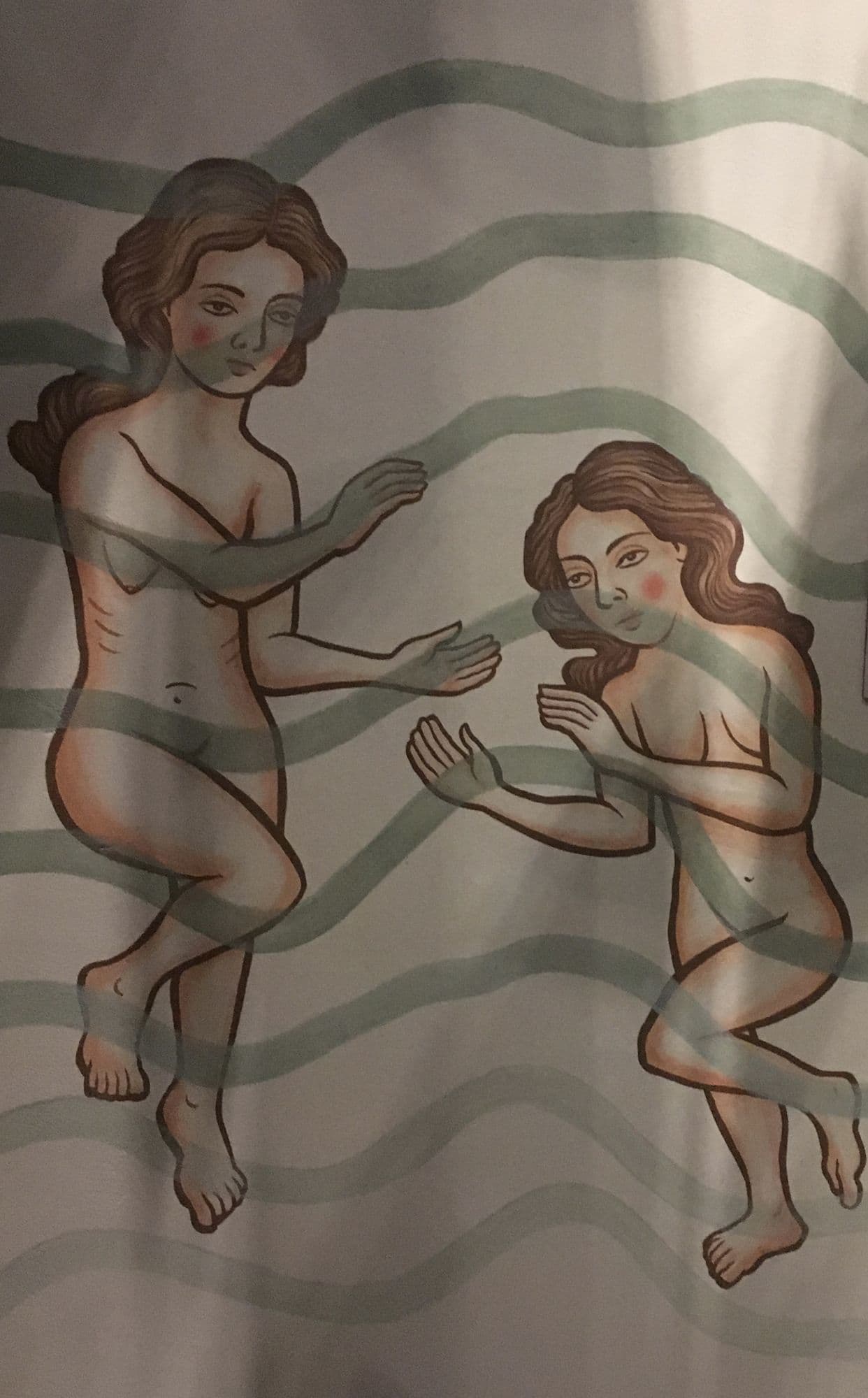
Art of women bathing
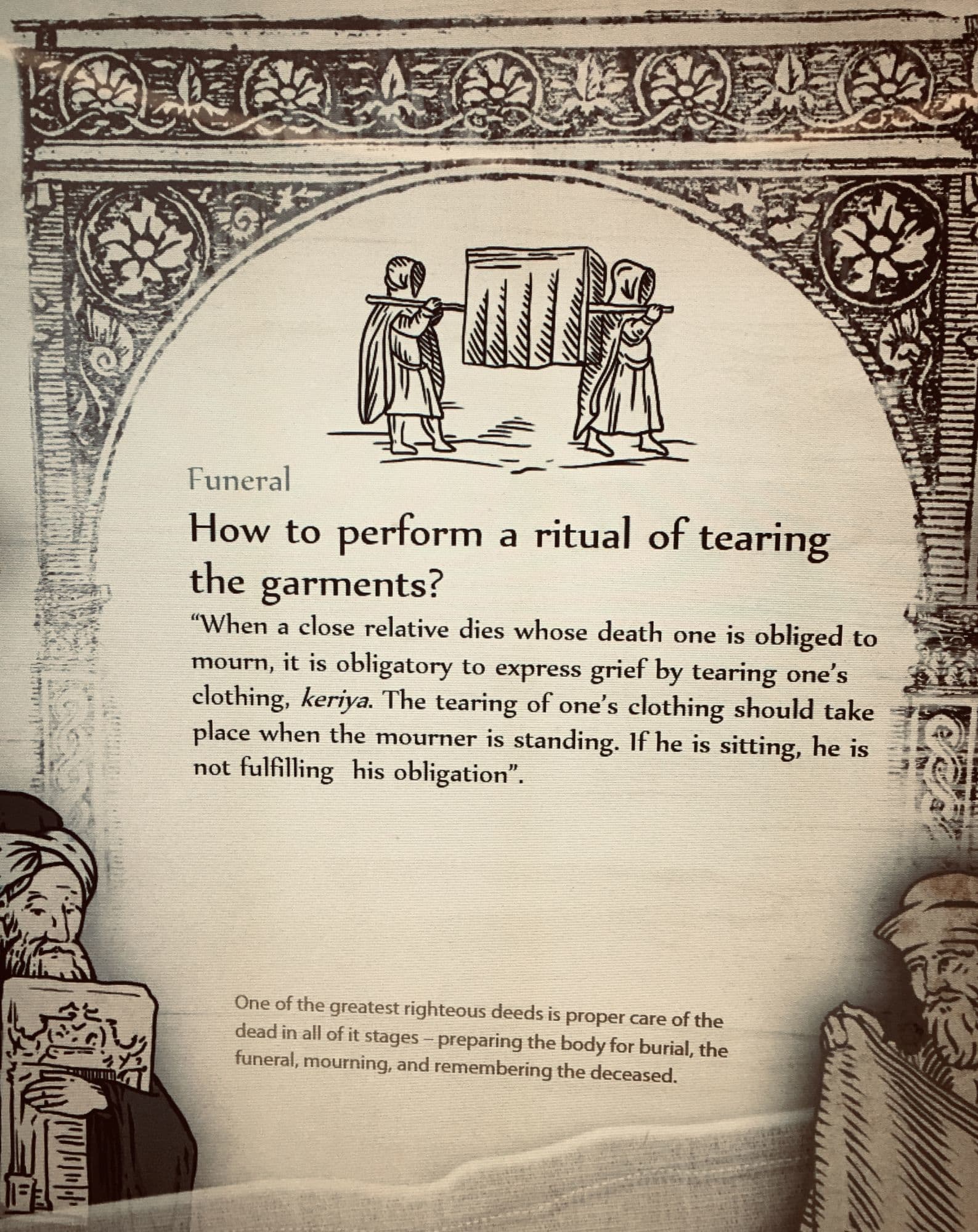
Part of a display on wedding and funeral rituals

A copy of Roli, an anti-Semitic newspaper

A cutout of Sarah Silberman, a prominent theater patron in Łódź who funded “cheap theater tickets.”

A chuppah

A young Sholem Asch (playwright of God of Vengeance)
These photos are far from comprehensive. It is important to note that there are very few photos of the portion of the museum devoted, and powerfully so, to the Holocaust. This was one of several instances on this journey where I was either simply too overcome with emotion to take a photo, or felt that the photos I did take did any kind of justice to what I was experiencing. One beautifully curated space I must mention was the space devoted to Jews who went into hiding: a black wall descended from the ceiling. Another black wall ascended from the floor. At their juncture was a narrow, dimly lit inset, about 6 inches in my memory, imbedded with images and stories of those who went into hiding.
We ended our day at the theater where we had bought tickets the previous day – two marvelous shows produced by Komuna Warsawa, and directed by Cezary Tomszewsky.
That evening we returned home to an email from Marcin (who Wotjek, from Warsaw, connected us with):
Hello!
I ask my friend, to guide us thru the Ghetto. He grew up in this area. If it's not problem for You, please take a cab and come to my place. I live within the borders of formęr Ghetto. Łukasz (my friend) promised to spend about 2 hrs with us. Then I can show you cemetery, and would give you some directions for more explorations.
Regards
Marcin
Łódź
True to his word, Marcin met us at his apartment the next morning along with Łukasz and Misha, Marcin’s wonderful dog. Marcin is a musician, Łukasz a photographer and an activist who was born in Łódź. Both are deeply committed to preserving and keeping alive the memory of the Ghetto and the people who lived there. Łukasz, with Marcin translating, spent several hours giving us a tour of what remained in the Łódź Ghetto.
The Ghetto was in the district of Bałuty – which at the beginning of our play (1906) Lemml refers to as a village near his shtetl. It was incorporated into Łódź in 1915. According to Łukasz “it was the poorest district then, it is where they put the Ghetto, and it is still the poorest district.” Łukasz’s pride in being from here is palpable, as is his outrage as what has been done – and not done – to people living here over time.
Like Kraków, the architecture in Bałuty was not all destroyed. Unlike Kraków, much of it lives on in disrepair, which Łukasz was much exactly the same as it had been before the Ghetto. The following photos are from our walk through Bałuty.

Much of Łódź remains the same as it had been
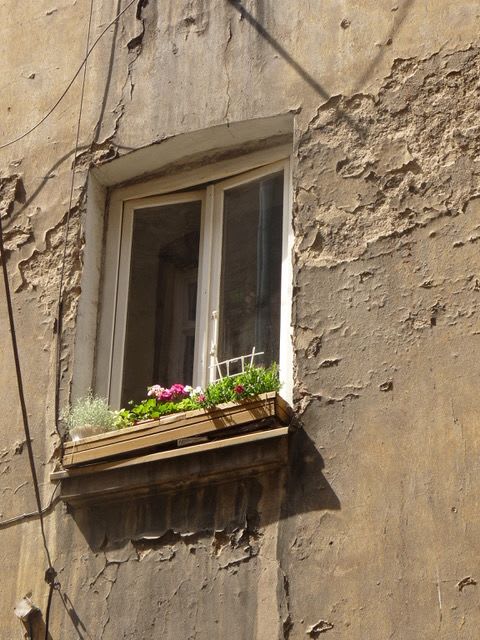
Beauty amidst the peeling walls

Street art depicting a child
Survivors Park
After 2 hours walking through Bałuty, we arrived in Survivors Park – a gorgeous and soothing stretch of green with many trees planted.

Each tree is planted by or for a survivor from Łódź. “Planting memorial trees by the survivors of the Litzmannstadt Ghetto was one of the important elements of this event. The idea was brought forth by one of the survivors-Halina Elczewska.”

In Survivors Park, a mound in tribute to Jan Karski - a Polish citizen who, at great risk, notified the Polish government in exile about what was actually happening to the Jewish people and others held in the Nazis' purported work camp
Also in the park lies a monument to Polish citizens who helped to save fellow Polish citizens who were Jewish.
Halina’s Tree
Located in the Center of Survivors Park is the Marek Edelman Dialogue Center.
Here Łukasz introduced us to his colleague Justina (sp), who works at the Center and like the others before her was so generous with her time and her feelings. We asked her about a photo from the Ghetto of a group of young people in a moment of laughter and what looked like pure joy and love: what she could share with us of how people found joy in such horrible circumstances? She lit up and asked us to follow her to watch a short film that would answer better than she could. The short film was about Halina Elczewska:
Halina Elczewska was born on November 11, 1919 in Łódź in the Polonised family of Maurycy and Franciszka. The outbreak of war and the creation of the ghetto meant that the family had to leave their apartment and move to the ghetto. During the liquidation of the ghetto, she was deported to Auschwitz on August 24, 1944 with the whole family. There, her husband, parents and younger sister Inka died. Only Halina and her sister Jadwiga and brother-in-law Arnold Mostowicz survived. She was transported from Auschwitz on October 6, 1944 to the Gross Rosen camp, and from there to Halbstadt, where she was liberated on May 9, 1945. From 1946, she lived in Wrocław, where she also married Maciej Elczewski, and in 1953 moved with his family to Warsaw. After her husband's death in 1957, she started working for TVP in the popular science department, where she worked until 1969. The anti-Semitic campaign led her to retire early, and a part of the family left Poland. She is the originator of the creation of the Survivors' Park in which she planted the first tree marked with the number "0."
Sources:
[jp] Podolska J., Halina Elczewska - survived and proposed Łódź Park of Survivors [in] Gazeta Wyborcza - Łódź from 20 VIII 2009

Halina's tree

Halina's plaque
The Jewish Cemetery
“ the largest Jewish cemetery in Europe, covering more than 40 hectares. About 230,000 Jews are buried here. During the war, an estimated 45,000 people were interred in the so-called Ghetto Field. “
Down a long narrow street, you enter through a metal door in a lime green wall. Marcin took us first to the office where we paid for entry, then to the morgue.
From there we began walking through the old part of the cemetery. Again the sound of wind everywhere – it is a peaceful place to begin with. Green and filled with beautiful trees. Row upon row of headstones, most in disrepair. Then comes the moment where you realize they are in disrepair and you can hear the wind and nothing else, because no one is left to take care of them. From that moment forward what was peaceful becomes empty, becomes haunting.

Older graves in disrepair
Time felt suspended in our walk through the old cemetery…and when we emerged it was at the Ghetto Field. Here are markers for people who lived and died in the ghetto. Some families have chosen to put larger headstones, but they are very few.
Lastly, we went to a newer part of the cemetery: here you could see newer gravestones with white stones laid upon them in memorial.

New gravestones in memoriam
Also here we looked at many plaques on the wall memorializing Łódź Jews who died in the death camps.
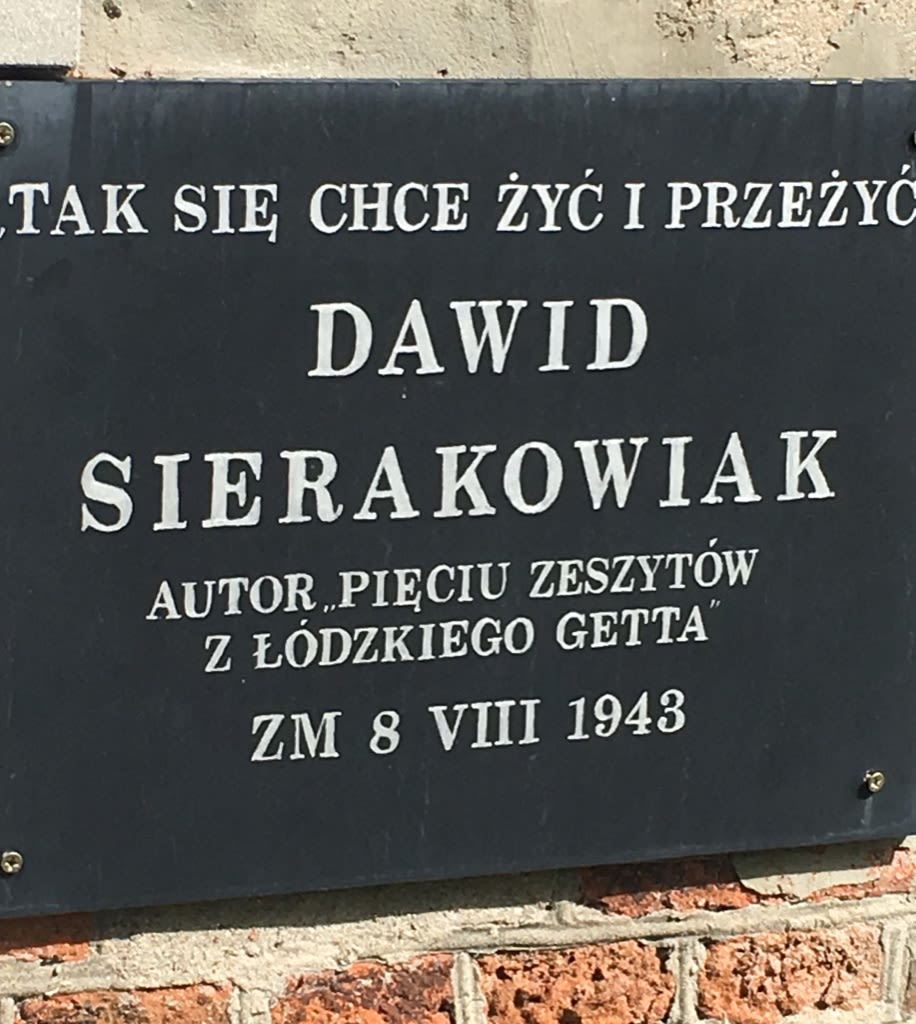
Dawid Sierakowiak was one of many children who kept a diary of his life in the ghetto
“Dawid Sierakowiak's diary ends in April 1943 with a hopeful note about getting a job in the ghetto bakery, where he would be able to eat. We do not know if he got this job or not, but we do know that this talented young man died on August 8, 1943, probably of tuberculosis. He wrote in his diary: ‘I so very much want to live and survive….’ Five notebooks of Dawid's diary survived." – from the web site for the United States Holocaust Memorial Museum
Upon leaving the cemetery we parted from Marcin. There are no words to express our gratitude for him.
Radegast Station: hidden in plain sight
“From this place, tens of thousands of people were herded off to the death camp at Chelmno-nad-Nerem in the years 1942-1944 and then to Auschwitz in August 1944”
There are no signs that we could see guiding our Uber driver to Radegast station: it was a sobering moment of understanding the size of Justine, Marcin and Łukasz’s task to remember and to create dialogue.
The main memorials were outside: a train car, a memorial of giant gravestones with the names of the camps humans were shipped to, and one more I will describe later.
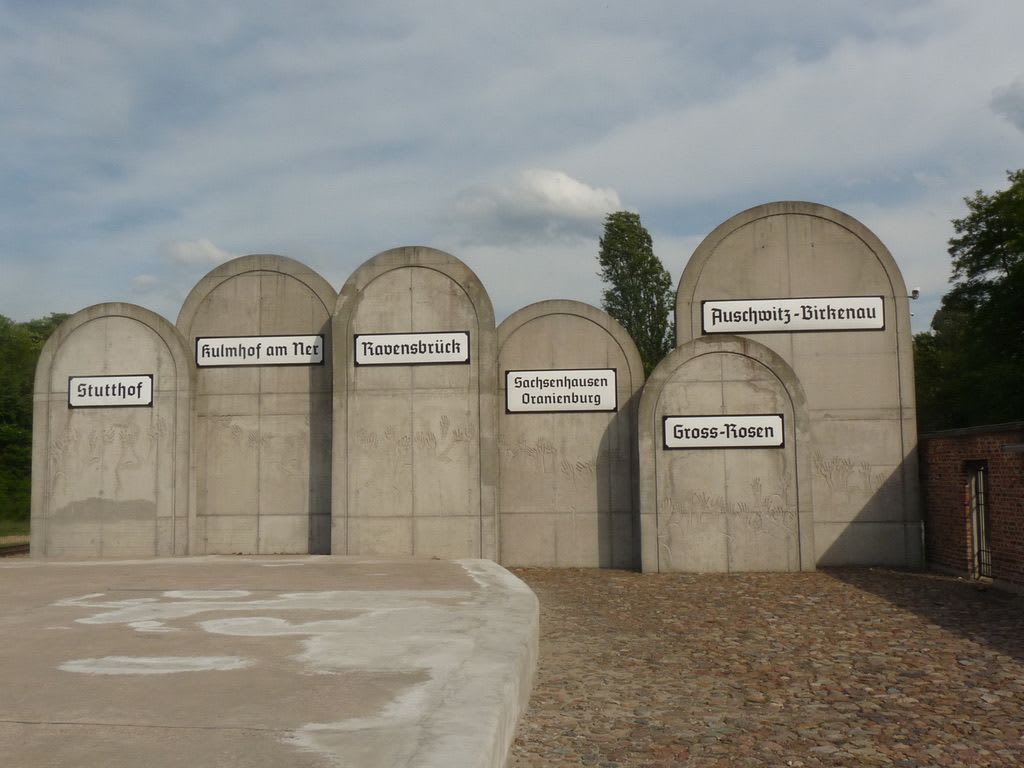
Gravestones with the names of camps people were shipped to

Map of the the Łódź Ghetto in the early 1940s
On tables next to the model were many large notebooks: in these notebooks were detailed documents kept by the Nazi’s of every person who came through the station. You can see below the documentation of whole families coming through – here it strikes you that for every family with one or two survivors, there are more families from whom no one survived. The weight of the precious human beings lost was piling up on us throughout this day.
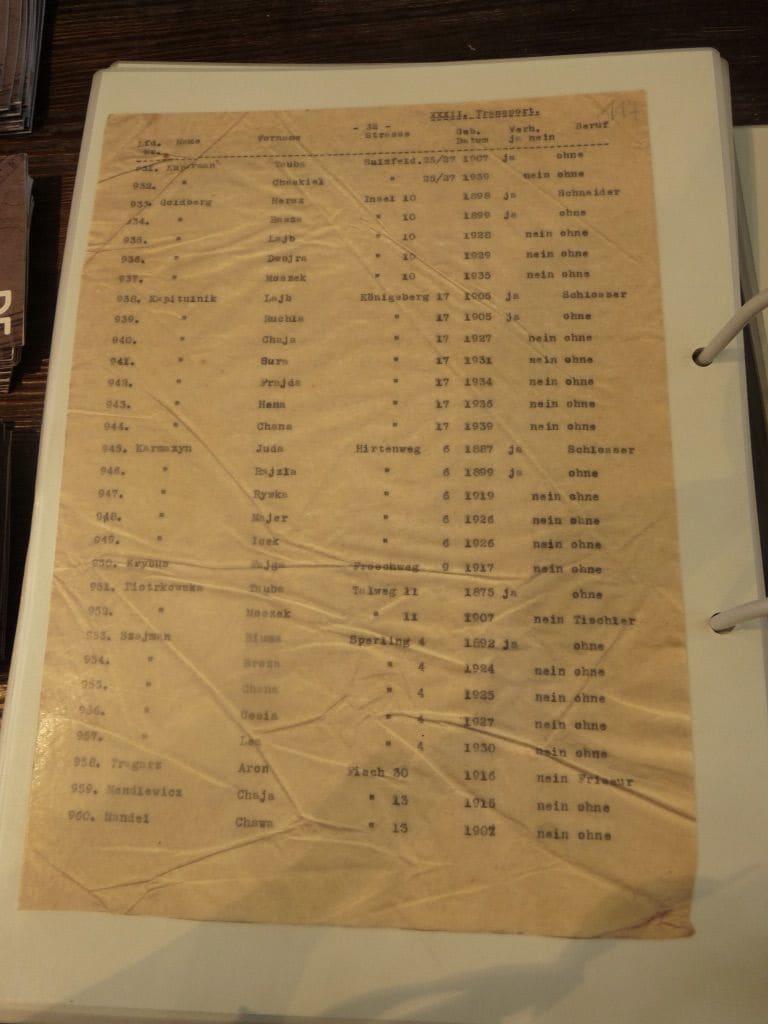
List of families that came through Radegast Station
Outside of the museum, a long and dark cement hallway greeted you. As you walked down it, lights would pop on illuminating the stories of deportations. Impossible to catch in a photo. At the end of the hallway lies a bright room, and carved into its walls are all the places from which the Nazis shipped their victims.

You then look up and realize you are looking up through a smokestack echoing the burning of these human beings lives.

As we stepped outside of this memorial, we turned to look back and carved into it on the outside are the words “Thou Shalt Not Kill."
After Radegast station, we headed to Lokal, a restaurant Marcin recommended. Again, yes, the kindness of the people and their willingness to help us muddle through our experiences.
Łódź is in a time of rebirth, and part of that is the work of the activists and artists there striving to memorialize, to remind, to activate dialogue and change. There obstacles are formidable, with a powerful Nationalist party in power, but no moreso than our obstacles here.
Auschwitz/Birkenau
There is little I can say about this day to convey how devastating it is to spend a day here. Emotions and sensations course through you rapidly – horror, grief, disbelief, rage. And also a determination to fight. This is where Never Again comes home.
Auschwitz: the personal.
Block 15: Extermination museum.

Rooms of photos, of pile of clothes and prosthetics and glasses and teacups and prayershawls. I attempt to take photos but find the lens to be a barrier.
We stop outside a room, dimly lit. Our guide instructs us to take no photos in the room, as its contents are fragile. In this room are two long glass cases filled with piles of the hair of a estimated 140,000 victims. The hair of those I love who are of Jewish heritage flashes through my mind: Lisa, Sarah, Jason, Libby, Tina, Tonya. Everything becomes deeply and irrevocably personal. You feel the difference in your entire group from this moment forward. Even the Crematorium you walk through later cannot touch the impact of this moment.
Implausibly, the beautiful song of a robin reaches you. The many stories of birds and their songs as hope for freedom, as relief from terror, settle into you.
Birkenau: the vast
Birkenau, also known as Auschwitz II lies a short distance from Auschwitz I, and here is the vast scope of genocide. Rows on rows of ruins, farther than the eye can see, of former bunks erected to cram human beings into.
After walking for about 10 minutes in relative silence, our guide shares with us that Birkenau is often called the largest graveyard in Europe. You realize in an instant that the ashes of over a million human beings lay beneath your feet. Every step thereafter it is as if people are crying out beneath your feet.
The other station
On leaving Birkenau, our guide tells us we have one more stop. We arrive at a train track with one train car standing alone. Our understanding from our driver is that here is the original place people were shipped to, and from here they walked to Auschwitz I. Note the stones laid upon the step to the car and along the tracks.


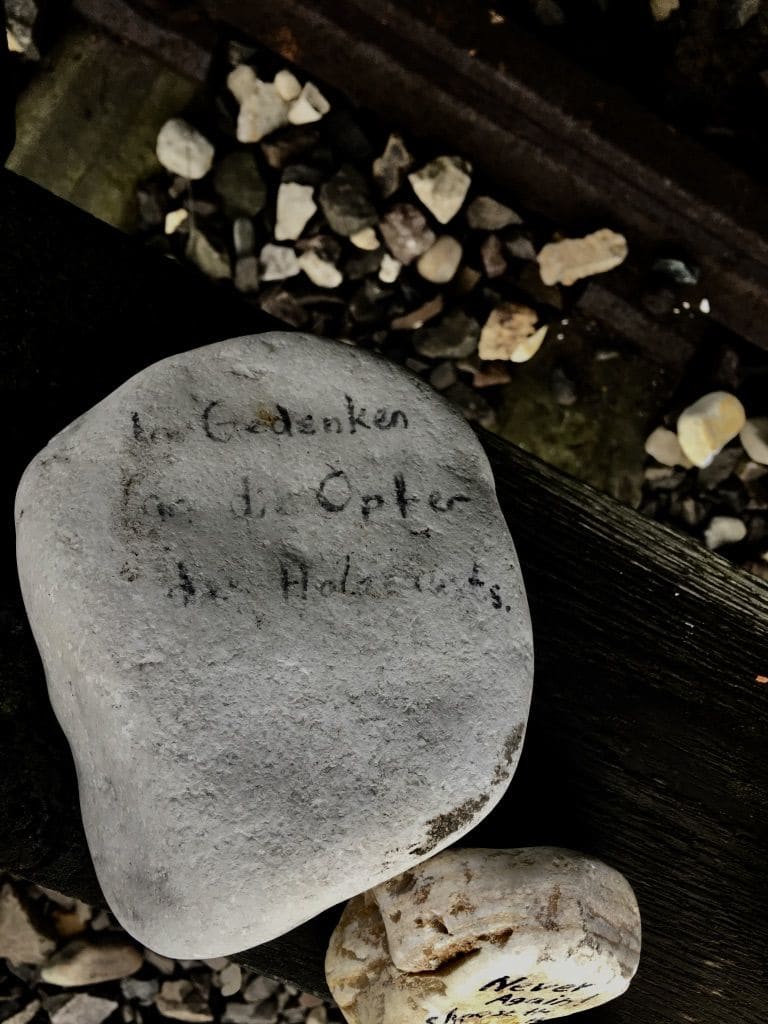
A stone with an inscription on the train track
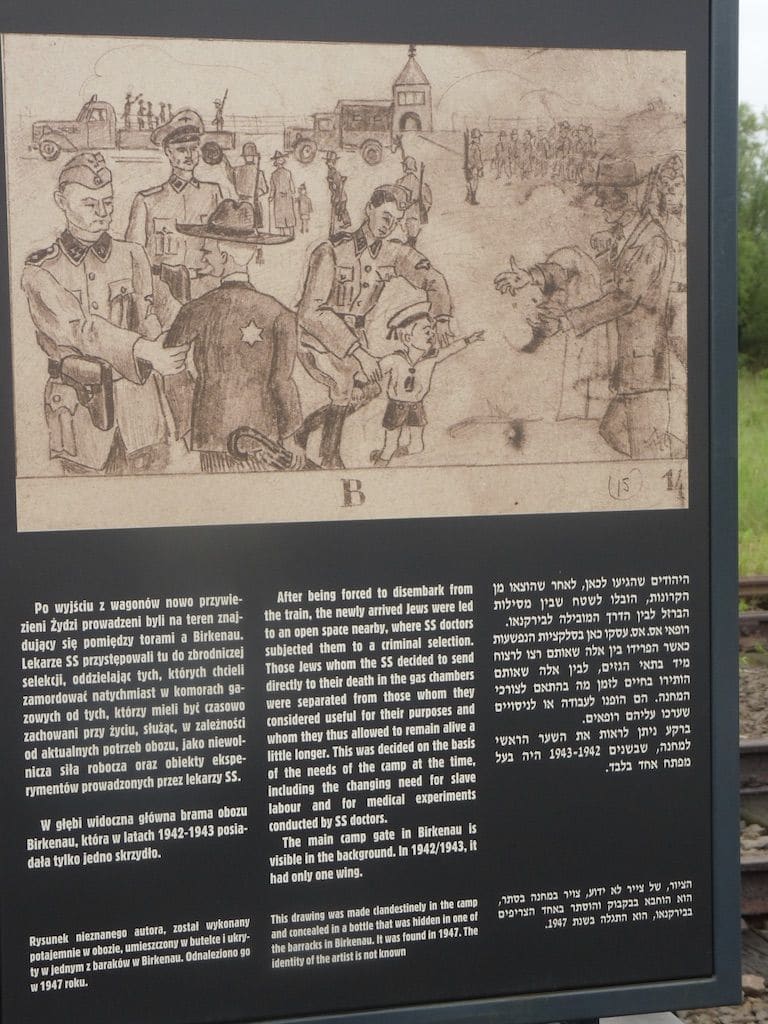

Art from a concentration camp survivor displayed by the train tracks
Kraków
Return to the present, into the future

Sheila's cousin Morgen in their AirBnB in Krakow
Architecture
Our last few days in Poland were spent exploring Kraków by foot, largely in the Old Jewish Quarter, Kazimierz. As I mentioned at the beginning, much of Kraków survived the second World War. It is a beautiful city: cobbled streets, lovely old buildings, and dynamic newer architecture as well.
Stara Synagogue: The oldest standing synagogue in Europe. Despite the Nazi’s attempts to ransack and totally destroy it, the Stare Synagogue, originally built in the 15th century was renovated in the 1950’s and stands today as a museum honoring the history of the Jewish people.


A painting of Shylock and Jessica by Marcin Gottlieb at the Stara Synagogue
Bernatek Footbridge: Deisgned by Jerzy Kędziora, this bridge crosses the Wisła river connects the Kazimierz and Podgórze districts of the city. It is “adorned with nine acrobatic, gravity-defying sculptures by Jerzy Kędziora.”

Gravity-defying sculptures by Jerzy Kedzjora
Music and Food
I would be remiss to not acknowledge the food and the music we experienced in Kraków. To be to the point – all the food we had was delicious!

Street food - kielbasa in Krakow


In Kazmierz, we spent one lovely evening in the restaurant at Hotel Klezmer-Hois, known for live klezmer music every night at 8. A trio of young men on violin, accordion and bass played their versions of traditional Klezmer music. We were lucky to be seated right next to them where we could experience the music directly.
Throughout Kraków is street art – a huge variety from small pieces hidden near drainpipes to giant murals.


Street art in Krakow
The below famous mural honors the Bosak family, whose descendants lived in the building for 400 years before the Nazi occupation and creation of the ghetto: the building is on the border of the Kraków Ghetto.
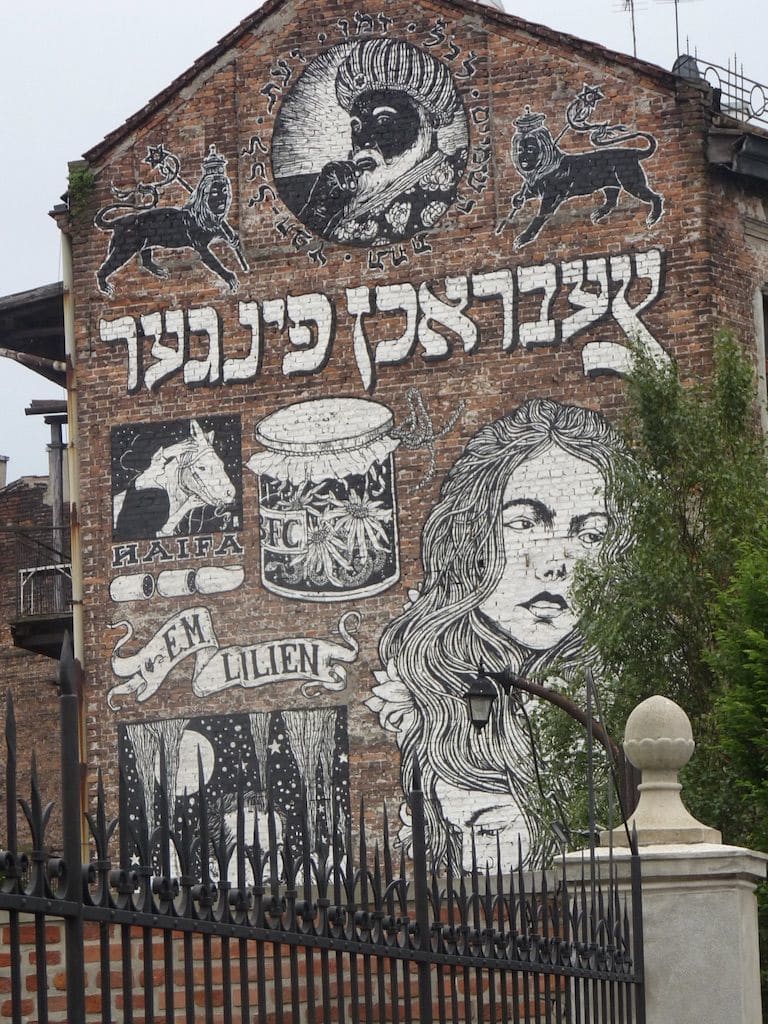
The below pieces by Bartolomeo Koczenasz are scattered throughout Kraków, titled “1932 -2019: Beyond the Past and the Present.”
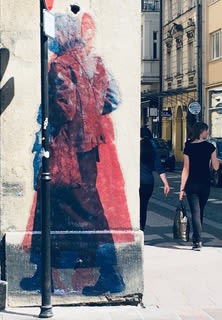

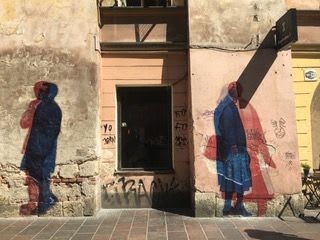
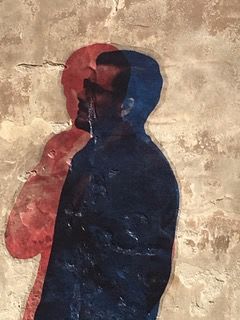
These capture the feeling of renewal I experienced in our return to Kraków.
The truth is, no words or photos can ever express what it is to experience a place and a people, and in this case the haunting sense everywhere of all the people and their histories lost through genocide. My hope for the future of Poland lies in the people we met, who welcomed into their lives.
- Sheila Daniels, Director of Indecent
This trip was funded by the Cornish College of the Arts.

